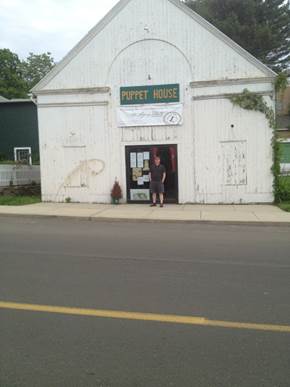When we were friends in 1980 and 1981, I asked the famous novelist what was the favorite time of her life.
"Hands down," she said smiling and closing her eyes to help the memory's flood in, "the summers in Stony Creek when I was writing in the stone house and Frank was performing in the Night of January 16th."
She said those were the happiest times of her life. Later, she showed me a picture of them together on the dock similar to the one now famously used around the world. She went on in great length about how the idea for Howard Roark working in a quarry came from her time in Stony Creek. I realized that for Rand a lot of important things occurred those two summers on the water in Stoney Creek. Certainly one of the most beautiful places in the world -- I could see how she and her husband would love it. I remember her saying "I miss him so much," her eyes filling with tears.
Years later, I would learn a lot about Stony Creek -- one of the five towns of the gorgeous Branford, Connecticut where so many famous authors had lived. The West Hamptons of its time -- both Sinclair Lewis and Jack London spent time in this picturesque community. London wrote an adventure called Call of the Wild when he was living at the Nellie Green in Branford, at that time a boarding house. Coincidentally, my brother would move to Short Beach -- like Stony Creek, Indian Neck, and Pine Orchard, a village in Branford -- and raise a family in this idyllic town on Long Island Sound, with its famous summer festival that attracts tens of thousands of people. As my nephew Spencer said, "It is a perfect place to grow up. It's just the right size as it has everything that a big town has with a small town environment." I sense almost all of the 28,000 inhabitants of Branford would agree.
I always wanted to see the legendary Stone House in Stony Creek where Rand had worked for so many hours creating Anthem and thinking about the plot of The Fountainhead, which opens in the nearby quarry. Some of the finest granite in the world comes from this area. She told me that in this writing haven is where she took her work to a whole new level.
So my brother Jack and I set out on our adventure. First, we went to the Puppet House -- a local theater which I had always wanted to see. It's now closed; I put my hand on the door and wished it well, trying to envision all the artists that had walked through the doors.
Ironically, as I was taking the picture below, one of my family's closest friends drove by with her husband in a beautiful sports car. They are supporters of the world of youth entrepreneurship and a funder of the Network for Teaching Entrepreneurship which I founded in 1987 (www.NFTE.com). Unable to get their attention, I captured the moment by snapping Jack's picture.

Then it was off to 16 Halls Point Road, the address where Rand had spent her two perfect summers working and writing. As I pulled up, we called out to a nice man sitting on the porch of a house across the street. Soon, we were talking and he explained how Rand had worked in the stone house but had lived in his house which he owned. His name was Gil Kelman -- a former newspaper owner, he had a whole file on Rand as well as a picture from her on his wall that he promised to show me next time I visited. I knew we would be friends forever, and that this would be just my first story on Branford and its hidden literary treasures.

